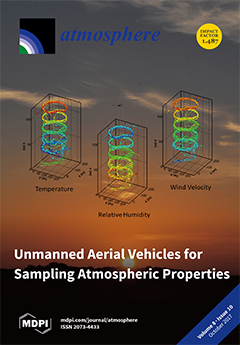Ambient concentrations of both fine particulate matter (PM
2.5) and particulate matter with an aerodynamic diameter less than 10 micron (PM
10) were measured from 10 June 2015 to 13 July 2015 at three locations surrounding the Cheswick Power Plant, which
[...] Read more.
Ambient concentrations of both fine particulate matter (PM
2.5) and particulate matter with an aerodynamic diameter less than 10 micron (PM
10) were measured from 10 June 2015 to 13 July 2015 at three locations surrounding the Cheswick Power Plant, which is located between the boroughs of Springdale and Cheswick, Pennsylvania. The average concentrations of PM
10 observed during the periods were 20.5 ± 10.2 μg m
−3 (Station 1), 16.1 ± 4.9 μg m
−3 (Station 2) and 16.5 ± 7.1 μg m
−3 (Station 3). The average concentrations of PM
2.5 observed at the stations were 9.1 ± 5.1 μg m
−3 (Station 1), 0.2 ± 0.4 μg m
−3 (Station 2) and 11.6 ± 4.8 μg m
−3 (Station 3). In addition, concentrations of PM
2.5 measured by four Pennsylvania Department of Environmental Protection air quality monitors (all within a radius of 40 miles) were also analyzed. The observed average concentrations at these sites were 12.7 ± 6.9 μg m
−3 (Beaver Falls), 11.2 ± 4.7 μg m
−3 (Florence), 12.2 ± 5.3 μg m
−3 (Greensburg) and 12.2 ± 5.5 μg m
−3 (Washington). Elemental analysis for samples (blank – corrected) revealed the presence of metals that are present in coal (i.e., antimony, arsenic, beryllium, cadmium, chromium, cobalt, lead, manganese, mercury, nickel and selenium).
Full article





